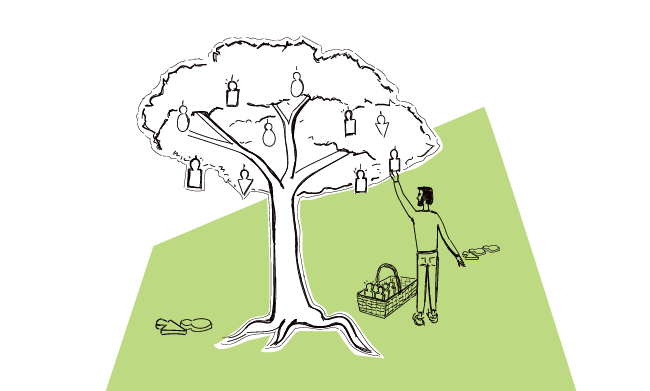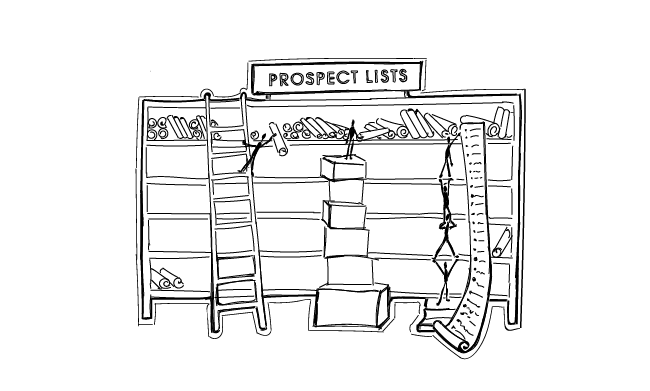Question: Is there a golden way for getting a quality contact list of sales leads? The answer, sad but true: No, there isn’t. But there are at least three good enough ways worth trying. All of them have their pros and cons. Not all of them will match your particular process of generating sales leads. The key is to choose those that work best for you and your company. Here’s a short analysis of the three ways to help you decide where to start from.
Way #1: Build it yourself
What the process looks like
In the first step, you define your Ideal Customer Profile. You choose a specific type of companies you want to work with.
Then, you go to a place on the web where members of these companies gather and exchange thoughts and ideas (like LinkedIn, Facebook groups, Quora, GrowthHackers, etc.) Even better if you engage in the community activities to become a familiar face. During the process, you learn their problems, ideas, and beliefs.
Then, you collect a list of names, along with their company names, titles, and preferably some references (e.g. to something they wrote or shared) for more personalized snippets. You literally create parts of your emails, having in mind the first draft of your copy. I described the process in more detail here. Then you use some tools to help you find email addresses of your sales leads.
+ Pros
This is the way that allows you to build very well targeted lists. Because you do the research yourself, you actually get to learn who your sales leads are. As a result, you are able to write recipient-centered copy that is sincere and feels natural. And it works great.
This is the way I used to build lists of sales leads for my most successful cold email campaigns. I still have relations that have been started by those campaigns. Some of Woodpecker‘s loyal customers come from those campaigns.
– Cons
Obviously, that’s an approach that is very hard to scale up. It’s time-consuming and the lists you build do not include hundreds, but rather dozens of contacts. The limited number of sales leads makes it difficult to carry out some reliable A/B tests of various copy versions.
Conclusion
Nonetheless, this is the way you need to try, not only because it works, but also because it actually allows you to get to know your ideal prospects and understand a lot about the process of effective cold emailing.
Way #2: Outsource building a list full of sales leads
You can find some people who offer a service of outbound list building. Or you can hire a person who will be taking care of it for you inside your company. That’s not as easy as you may think, though. It’s a good idea to go the Way #1 first to work out the sales leads list building process yourself before you decide to outsource it.
And I don’t mean just collecting emails. Email addresses are the easiest part to get. The person who is going to handle the list building for you needs to know if the prospect matches your Ideal Customer Profile or not. They need to know, or rather feel, which information to choose for your email personalization snippets.
Moreover, they need to be able to put the words for the snippets in a way that makes the email feel natural to the recipient. In an ideal scenario, they need to be immersed into your whole outbound outreach process.
+ Pros
By outsourcing the process, you keep a high quality of your cold email outreach, and you regain the time that normally you would have to spend on finding the sales leads yourself. As a result, you gain a skilled SDR (Sales Development Representative) who takes care of starting business relations, which may bring you some new deals after some time.
– Cons
If you decide to outsource the outbound list building, you obviously agree to invest more money into the process. What you’ll get in return, though, is your own precious time. Finding the right person, who will get your assumptions about generating sales leads, and will follow them to create valuable cold email messages, is a complicated process. Plus, at the beginning of your cooperation, you will have to invest some of your time into proper training.
Conclusion
But I believe this is the only way to scale the process of contextual prospect list building. Looks like I’ve just coined the phrase, so let me explain what I mean by that.
I would define contextual prospect list building as collecting prospects that not only match your ICP, but also match the particular cold email campaign you’re preparing. This way of building your lists allows you to keep the emails highly-personalized and, at the same time, adapted to be sent automatically. I described the process step by step here.
Of course, you can very easily outsource building a basic prospect base including just emails, names, and links to websites and social profiles. But then, how are you going to start your message? “I found you on Linkedin”? Gosh, I’ve seen that too many times. I bet we all have.
Heck, we’ve even done that for a while at Woodpecker to experiment and check if it works. Trust me, it doesn’t. I believe it’s becoming less and less effective with every email starting this way. And too many people do that because it seems so simple and effortless.
Of course, a lot depends on your target group, and maybe if you’re addressing a market that is approached by other channels more than by email, the “I found you on LinkedIn” may be enough to start a conversation. But for the market I know, and most of us really aim at, it’s not enough anymore.
Way #3: Order it from a list building company
Yes, there’s also an option to order list building as a service. There are companies who specialize in this kind of tasks. They will schedule a consult with you first to talk about your Ideal Customer Profile. They will also offer you a variety of data they can collect about your prospects. This data will not be contextual though. Most of the prospect list building companies will offer you a collection of names, emails, phone numbers, websites, and perhaps a bit more advanced information, like for instance a particular technology your prospects are using at the moment.
You can find links to some list building companies in this post.
+ Pros
This way definitely is the most time-efficient of all, and probably the most cost-efficient as well. You don’t have to hire anyone and train them for the process.
The good thing is you get to explain your exact requirements about the prospect profile, and someone will actually prepare a list for you on the basis of these requirements rich with sales leads. If your target market can be segmented on the basis of the technology they use (for instance, you’re looking specifically for software houses specializing in Magento) because you’re offering a solution that perfectly matches this technology, then perhaps this way of list building will work for you. A lot depends on targeting, really.
– Cons
If you order a list of sales leads, you don’t really get to know the contacts before you reach out to them. It’s more difficult to prepare a convincing cold email copy that sounds natural, when all you have is a bunch of raw data without any context to refer to.
You can, of course, refer to their website, but it would be great to have at least one snippet that shows you did your homework, and not just copied and pasted their website address. And that requires additional research, along with collecting the data in a form that in result will match your email copy. I’m not sure if any of the list building companies offer to collect contextualized snippets, but if they were – that would be great.
Conclusion
We’ve tried this way at Woodpecker once or twice. But it didn’t allow us to reach the level of personalization which contextual list building did. Sure, you can stick to customizing your messages and rely on segmenting your lists, in hope that a well-crafted pitch focused on benefits will bring you some answers. But this will work only for some types of markets. And you need to find out if the one you’re aiming at is of them.
Way#4 … ?
I described three ways of getting quality prospects for outbound. But I bet some of you have in mind the fourth one. If you’re thinking about buying a ready-made list of sales leads, like 250K contacts to VP of sales and marketing at IT companies, I have 5 words for you:
DO NOT BUY READY-MADE LISTS
Why not to buy ready-made lists?
Buying bulk lists… That’s so 2004 approach (and the lists are, too, most probably). I can’t imagine how to prepare a targeted email outreach to a list of hundreds of thousands of contacts…
If you think it’s a game of numbers, and that it makes sense to send thousands of emails in hope that if you throw spaghetti on the wall, some of it will stick, then you sooo need to get back to this post.
Honestly, I don’t see any pros of buying such lists. But there’s a number of cons. Let me list just a few of them:
- Firstly, you have no guarantee that such a list includes valid email addresses. Many types of data, not only email addresses, change over time. Even if some emails and domains existed in 2004, it doesn’t mean they still exist. And what happens when you send the email to a non-existent email address? You get a hard bounce.
- If you get many bounces (which isn’t that hard to achieve, if you send to thousands of addresses), you look like a spammer. That obviously may trigger your email provider to block you from sending all kinds of emails. What’s more, your IP, and hence your domain, may get on a blacklist. So by sending to a large non-targeted list that you bought on the web, you risk not only low deliverability, but also the reputation of your whole domain.
- Secondly, you won’t have the faintest idea who your prospects are. You won’t know their interests, pain points, or needs. Hence, you won’t be able to write an attractive email copy, not to mention adding personalization snippets. You won’t be even sure if the people you’re sending your emails to could be at least slightly interested in what you’re offering.
- Thirdly, some of the email addresses on such a list might be spam traps. What is a spam trap? Basically, it’s an email address set up solely for the purpose of catching spammers red-handed. The organizations or companies that set them up don’t actively use them, but they keep an eye on them to see if they receive any emails. The idea behind this is since nobody is actively using them, they couldn’t have opted-in to any email lists – and shouldn’t be getting any emails.
- Finally, remember that more people than just you also bought the same ready-made list. They’ve all sent non-targeted, impersonal cold emails to the very same group of people. That means, your target group has already been bothered by so many cold emails and cold calls that they a) got immune to this channel and will simply ignore you no matter what, or worse b) they will get furiously enraged by your outreach. Either way, you won’t achieve the reaction that you expect.
So what’s the point? I seriously don’t see any possible positive outcome in this scenario. That’s why I’ve never done that myself. But if you have a different point of view, and if you have seen some positive effects of sending to a huge, ready-made list bought on the web, I’m dying to hear your story.
Final words
I wrote that at the beginning, but I’ll write it once again for a greater emphasis: there is no golden way that we all can use to generate sales leads. You need to figure out the best way for yourself. I’ve just shown you three ways that I’ve tried so far.
Undoubtedly, there are more ways than that. If you’d like to share your own way, feel free to leave a comment underneath or email me with your story.
No matter what you pick or come up with yourself, make sure to stay focused on your prospects. Keep in mind the goal of your outreach. Verify, if your way does not disqualify you from getting positive responses in the end.
After all, it’s not a competition of who can get more sales leads faster and cheaper. It’s about how many of the contacts you get can be actually converted into valuable business relations.
READ ALSO

Account Based Sales Development 101: What Is It? How Does It Work?
If you're doing outbound sales, you've probably heard about the ABSD (Account Based Sales Development) trend lately. Is it new? Is it for everyone? Is it a revolutionary approach that will bring you $$$ as soon as your sales team adopts it? What is it, really? Check out the short introduction to ABSD in simple words.

How to Build a Quality Prospect Base for Outbound: 5-Step Tutorial
In 2016, I wrote around 20 posts about prospecting tools and tactics. I decided to prepare a little synthesis of the prospecting know-how I've shared with you so far. Here's the outbound prospecting process divided into 5 steps.

How to Manage a Sales Team to Make Prospecting Predictable?
Outbound emailing requires a lot of research into a target group and A/B testing before it can take off and become truly predictable. It's not unusual that a sales team (ours included) loses its motivation before that happens. Either that or they lose focus and target prospects ad hoc, just to get their numbers right. There is something that helped us. It is a proper goal setting.

